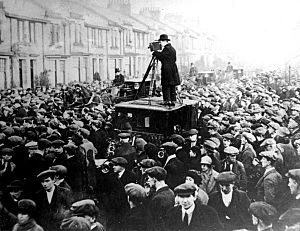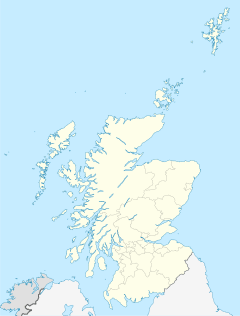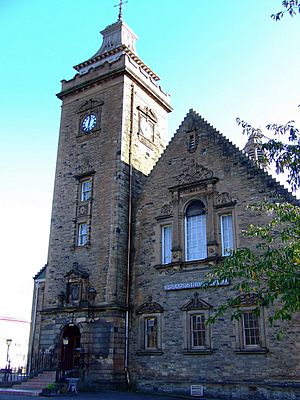Pollokshaws facts for kids
Quick facts for kids Pollokshaws
|
|
|---|---|
 Pollokshaws Clock Tower |
|
| Population | 14,295 |
| OS grid reference | NS562614 |
| Council area | |
| Lieutenancy area |
|
| Country | Scotland |
| Sovereign state | United Kingdom |
| Post town | GLASGOW |
| Postcode district | G43 1 |
| Dialling code | 0141 |
| Ambulance | Scottish |
| EU Parliament | Scotland |
| UK Parliament |
|
| Scottish Parliament |
|
Pollokshaws (Scots: Powkshaws) is a lively area in the south of Glasgow, Scotland. It sits next to other neighbourhoods like Auldhouse and Shawlands. To its west, you'll find the railway line and the big, open spaces of Pollok Country Park. The White Cart Water river also flows right through the area.
The homes here are a mix of old and new. You can see traditional sandstone tenement flats, modern brick buildings, and some taller tower blocks. Many older tower blocks were taken down in recent years. However, four tower blocks still stand near Pollokshaws East railway station.
In 2001, about 4,295 people lived in Pollokshaws. The community is made up of people from different backgrounds. It also has a large South Asian community.
Contents
A Look Back: Pollokshaws History

Pollokshaws started as a small village in the 1600s. It was mostly known for its weaving. In the 1800s, skilled weavers from Flanders were brought here. They were invited by the Maxwell family, who owned the land, because of their amazing weaving talents.
Becoming a Burgh
In 1812, Pollokshaws was given a special permission to become a Burgh of Barony. This meant it could govern itself in some ways. Later, in 1858, it became a police burgh. This gave it more control over things like law and order.
Pollokshaws was part of Renfrewshire until 1912. That year, it officially became part of the larger Glasgow city.
Modern Changes
After being an industrial area for a long time, Pollokshaws changed a lot in 1957. It was chosen for a big rebuilding project. This meant many old buildings were taken down and new ones were built.
Several tower blocks were built in the 1960s as part of this plan. Most of these were later taken down between 2008 and 2016. New, smaller homes have replaced them. A few tower blocks still remain in the area today.
Important Places in Pollokshaws
Pollokshaws Burgh Hall
The Pollokshaws Burgh Hall is a beautiful building on Pollokshaws Road. It was built between 1895 and 1898. The architect, Robert Rowand Anderson, designed it in the Scots Renaissance style.
This hall was once the main office for the independent town of Pollokshaws. When Pollokshaws joined Glasgow, the city council took it over. It is now a Category A listed building, which means it's very important historically. After being closed for a while, a charity group reopened it for community use.
Sir John Maxwell School
Sir John Stirling Maxwell Primary School was a red sandstone building. It was finished in 1907. The land for the school was given by Sir John Stirling Maxwell, a kind local landowner. The school was named after him.
The school closed in 2011. Even though local people tried to save it, the building became very run down. It was taken down in 2023 because it was unsafe. The council hopes to use some of its old features in a new project.
Pollokshaws Clock Tower
The Pollokshaws Clock Tower on Pleasance Street is a very old landmark. It's the only part left of the original Town House, which was built in 1803. The old Town House had a school on the ground floor. Above it, there was a courtroom and a police cell. A library was also added in 1818.
The Town House used to hold courts for legal cases and crimes. A jail was built in 1845 for local lawbreakers. When Pollokshaws became part of Glasgow in 1912, most of the Town House was demolished. Luckily, a public effort saved the Clock Tower we see today.
The Round Toll
The Round Toll is a unique circular building. You can find it in the middle of a roundabout. It was built around 1820 as a tollbooth. This was a place where people paid a fee to use the roads.
It's the only old tollbooth left in this area. Many others were lost when roads were developed. It's also a rare old building in Pollokshaws after many older homes were cleared in the 1900s. It is now a Category B listed building. After road tolls ended in the 1880s, it was used for different things. It was a place to hire carriages, a pub, and even a private house. Today, it is empty.
Sports and Recreation
Pollokshaws Bowling Club
The Pollokshaws Bowling Club started in 1854. It was first located across from Pollokshaws West railway station. For its 100th birthday, the club moved. Sir John Stirling Maxwell allowed them to use land in Pollok Park for free.
Pollokshaws Races
From about 1750 to 1883, Pollokshaws hosted informal horse races. These races took place southwest of the village. The area is now home to Kennishead Road and Cowglen Golf Club. The races were part of a local holiday, the Pollokshaws Fair. They were more about having fun and socialising than serious competition.
Pollok F.C.
The local football team, Pollok F.C., has its home ground in the area. Their stadium, Newlandsfield Park, is right next to Pollokshaws East railway station.
Well-Known People from Pollokshaws
Many notable people have connections to Pollokshaws:
- Frankie Boyle - a comedian
- Elizabeth 'Betty' Burns - the daughter of famous poet Robert Burns, buried in Kirk Lane Cemetery.
- Jack McLean - a well-known Glasgow writer.
- John MacLean - an important socialist leader from the early 1900s.
- Alex Norton - an actor.
- James Maxton - a political activist.
- James Tassie - an 18th-century artist who engraved gems.





